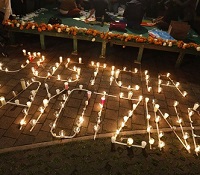
The disappearance of 43 students from a rural school in Ayotzinapa, Mexico dedicated to training teachers that are mostly from indigenous communities has sparked outrage and solidarity throughout Mexico and the world.
![]()
Source: Toward Freedom
The disappearance of 43 students from a rural school in Ayotzinapa, Mexico dedicated to training teachers that are mostly from indigenous communities has sparked outrage and solidarity throughout Mexico and the world. These horrible acts of violence must be understood within the context of an increasingly vile and murderous narco state.
The outrage has slowly gained momentum and grown into massive demonstrations in solidarity with the families of the 43 students. Though social media has been useful in sharing critical information and calling for solidarity, it is the strong network and infrastructure of independent media and community activists that has responded. Many have been consistently involved in engaging the struggles of the global south while actively working in their local communities.
The Ayotzinapa atrocity happened only a few days prior to the 46th anniversary of the October 2nd Tlatelolco Massacre of 1968, when around 500 students were killed and thousands were injured at the hands of police. Similar to the recent events in Ayotzinapa, the 1968 violence was largely ignored by the mainstream media and state political leaders. This silence has been historically imposed by governments and elites as part of a strategy to maintain the illusion of good governance and institutional truth.
However, the moments of silence that are most significant in the case of Ayotzinapa have been those that have been reclaimed and used to commemorate, honor, and remember the lives of the current victims of state violence. This silence is not one of apathy, disengagement or withdrawal but one of strategic refusal to participate in the dominant narratives and frameworks that reinforce violent institutions, a silence where participants are able to reflect and listen to each other’s struggles. Though a moment of silence is a common practice when mourning, or as part of a historical commemoration, recently silence has been politicized to reflect, analyze and regenerate community.
During the Ferguson October, where thousands marched in St Louis, Missouri, a four-minute moment of silence was observed to represent each hour in which Mike Brown’s body, who was shot and killed by a police officer on August 9thof this year, was left lying in the middle of the street.
This is a silence that reminds us to speak and listen to each other, not to bureaucrats or politicians who either don’t know how to fix the problem or simply make the situation worse. This should not be misinterpreted as a call for silencing voices or demands.
The Zapatistas from Chiapas, Mexico continue to remind us of the possibility of a non-institutional alternative that is built by ordinary people and sustained as a politics of everyday life, through the construction of schools, clinics, community-based forms of governance, made visible by the Juntas de Buen Gobierno, and the efforts toward autonomous justice that is applied through collective agreements.
Recently, the Zapatistas have maintained a very deliberate and strategic silence. This is not a silence of resignation, defeat or dismissal; they have been in a very active dialogue with people from all over the world, through communiqués and encuentros, as well as through their participation in public actions in solidarity with communities across Mexico.
After a silent march of well over 40,000 Zapatistas throughout Chiapas on December 21, 2012 they stated, “with our silence, we have made ourselves present.” They have continued to march in silence and yet have made themselves present to “try to construct the necessary bridges toward the social movements that have arisen and will arise, not to direct or supplant them, but to learn from them, from their history, from their paths and destinies.”
Through these public demonstrations we see that the Zapatistas have not only been able to listen to struggles from all over the world but have also been responding. While the silence of the state reinforces its complicity in maintaining the drug war and the immense violence against the people of Mexico, the silence from below speaks of a shift in focus, where those at the grassroots speak to each other, build on their level of organization, and reinvigorate their commitment to struggling for a radically new type of politics.
Email: Armando Carmona armando2k7@gmail.com
